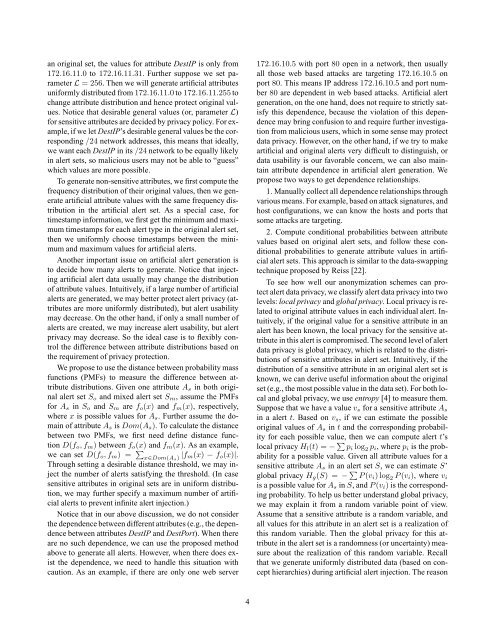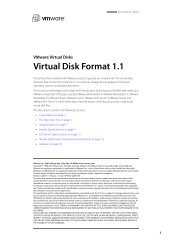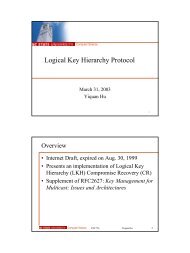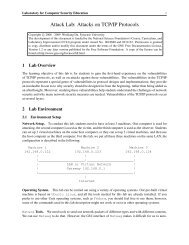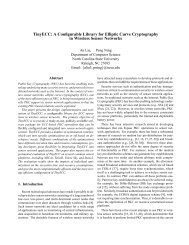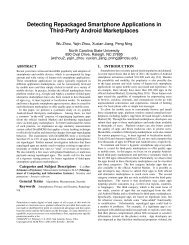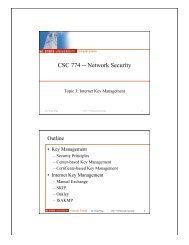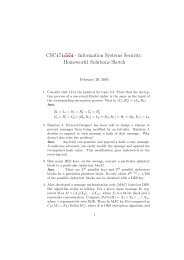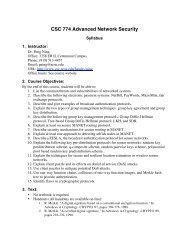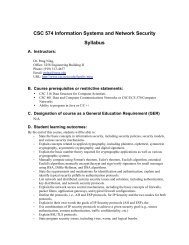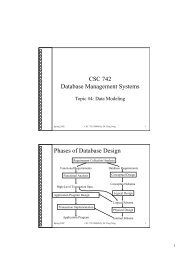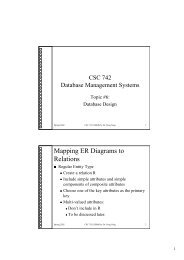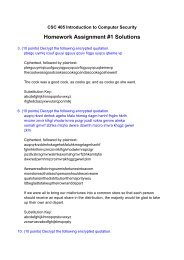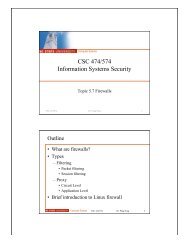A Flexible Approach to Intrusion Alert Anonymization and Correlation
A Flexible Approach to Intrusion Alert Anonymization and Correlation
A Flexible Approach to Intrusion Alert Anonymization and Correlation
You also want an ePaper? Increase the reach of your titles
YUMPU automatically turns print PDFs into web optimized ePapers that Google loves.
an original set, the values for attribute DestIP is only from<br />
172.16.11.0 <strong>to</strong> 172.16.11.31. Further suppose we set parameter<br />
L = 256. Then we will generate artificial attributes<br />
uniformly distributed from 172.16.11.0 <strong>to</strong> 172.16.11.255 <strong>to</strong><br />
change attribute distribution <strong>and</strong> hence protect original values.<br />
Notice that desirable general values (or, parameter L)<br />
for sensitive attributes are decided by privacy policy. For example,<br />
if we let DestIP’s desirable general values be the corresponding<br />
/24 network addresses, this means that ideally,<br />
we want each DestIP in its /24 network <strong>to</strong> be equally likely<br />
in alert sets, so malicious users may not be able <strong>to</strong> “guess”<br />
which values are more possible.<br />
To generate non-sensitive attributes, we first compute the<br />
frequency distribution of their original values, then we generate<br />
artificial attribute values with the same frequency distribution<br />
in the artificial alert set. As a special case, for<br />
timestamp information, we first get the minimum <strong>and</strong> maximum<br />
timestamps for each alert type in the original alert set,<br />
then we uniformly choose timestamps between the minimum<br />
<strong>and</strong> maximum values for artificial alerts.<br />
Another important issue on artificial alert generation is<br />
<strong>to</strong> decide how many alerts <strong>to</strong> generate. Notice that injecting<br />
artificial alert data usually may change the distribution<br />
of attribute values. Intuitively, if a large number of artificial<br />
alerts are generated, we may better protect alert privacy (attributes<br />
are more uniformly distributed), but alert usability<br />
may decrease. On the other h<strong>and</strong>, if only a small number of<br />
alerts are created, we may increase alert usability, but alert<br />
privacy may decrease. So the ideal case is <strong>to</strong> flexibly control<br />
the difference between attribute distributions based on<br />
the requirement of privacy protection.<br />
We propose <strong>to</strong> use the distance between probability mass<br />
functions (PMFs) <strong>to</strong> measure the difference between attribute<br />
distributions. Given one attribute A s in both original<br />
alert set S o <strong>and</strong> mixed alert set S m , assume the PMFs<br />
for A s in S o <strong>and</strong> S m are f o (x) <strong>and</strong> f m (x), respectively,<br />
where x is possible values for A s . Further assume the domain<br />
of attribute A s is Dom(A s ). To calculate the distance<br />
between two PMFs, we first need define distance function<br />
D(f o , f m ) between f o (x) <strong>and</strong> f m (x). As an example,<br />
we can set D(f o , f m ) = ∑ x∈Dom(A s) |f m(x) − f o (x)|.<br />
Through setting a desirable distance threshold, we may inject<br />
the number of alerts satisfying the threshold. (In case<br />
sensitive attributes in original sets are in uniform distribution,<br />
we may further specify a maximum number of artificial<br />
alerts <strong>to</strong> prevent infinite alert injection.)<br />
Notice that in our above discussion, we do not consider<br />
the dependence between different attributes (e.g., the dependence<br />
between attributes DestIP <strong>and</strong> DestPort). When there<br />
are no such dependence, we can use the proposed method<br />
above <strong>to</strong> generate all alerts. However, when there does exist<br />
the dependence, we need <strong>to</strong> h<strong>and</strong>le this situation with<br />
caution. As an example, if there are only one web server<br />
172.16.10.5 with port 80 open in a network, then usually<br />
all those web based attacks are targeting 172.16.10.5 on<br />
port 80. This means IP address 172.16.10.5 <strong>and</strong> port number<br />
80 are dependent in web based attacks. Artificial alert<br />
generation, on the one h<strong>and</strong>, does not require <strong>to</strong> strictly satisfy<br />
this dependence, because the violation of this dependence<br />
may bring confusion <strong>to</strong> <strong>and</strong> require further investigation<br />
from malicious users, which in some sense may protect<br />
data privacy. However, on the other h<strong>and</strong>, if we try <strong>to</strong> make<br />
artificial <strong>and</strong> original alerts very difficult <strong>to</strong> distinguish, or<br />
data usability is our favorable concern, we can also maintain<br />
attribute dependence in artificial alert generation. We<br />
propose two ways <strong>to</strong> get dependence relationships.<br />
1. Manually collect all dependence relationships through<br />
various means. For example, based on attack signatures, <strong>and</strong><br />
host configurations, we can know the hosts <strong>and</strong> ports that<br />
some attacks are targeting.<br />
2. Compute conditional probabilities between attribute<br />
values based on original alert sets, <strong>and</strong> follow these conditional<br />
probabilities <strong>to</strong> generate attribute values in artificial<br />
alert sets. This approach is similar <strong>to</strong> the data-swapping<br />
technique proposed by Reiss [22].<br />
To see how well our anonymization schemes can protect<br />
alert data privacy, we classify alert data privacy in<strong>to</strong> two<br />
levels: local privacy <strong>and</strong> global privacy. Local privacy is related<br />
<strong>to</strong> original attribute values in each individual alert. Intuitively,<br />
if the original value for a sensitive attribute in an<br />
alert has been known, the local privacy for the sensitive attribute<br />
in this alert is compromised. The second level of alert<br />
data privacy is global privacy, which is related <strong>to</strong> the distributions<br />
of sensitive attributes in alert set. Intuitively, if the<br />
distribution of a sensitive attribute in an original alert set is<br />
known, we can derive useful information about the original<br />
set (e.g., the most possible value in the data set). For both local<br />
<strong>and</strong> global privacy, we use entropy [4] <strong>to</strong> measure them.<br />
Suppose that we have a value v s for a sensitive attribute A s<br />
in a alert t. Based on v s , if we can estimate the possible<br />
original values of A s in t <strong>and</strong> the corresponding probability<br />
for each possible value, then we can compute alert t’s<br />
local privacy H l (t) = − ∑ p i log 2 p i , where p i is the probability<br />
for a possible value. Given all attribute values for a<br />
sensitive attribute A s in an alert set S, we can estimate S’<br />
global privacy H g (S) = − ∑ P(v i )log 2 P(v i ), where v i<br />
is a possible value for A s in S, <strong>and</strong> P(v i ) is the corresponding<br />
probability. To help us better underst<strong>and</strong> global privacy,<br />
we may explain it from a r<strong>and</strong>om variable point of view.<br />
Assume that a sensitive attribute is a r<strong>and</strong>om variable, <strong>and</strong><br />
all values for this attribute in an alert set is a realization of<br />
this r<strong>and</strong>om variable. Then the global privacy for this attribute<br />
in the alert set is a r<strong>and</strong>omness (or uncertainty) measure<br />
about the realization of this r<strong>and</strong>om variable. Recall<br />
that we generate uniformly distributed data (based on concept<br />
hierarchies) during artificial alert injection. The reason<br />
4


